加拿大地理方面 中英文
- 格式:ppt
- 大小:3.59 MB
- 文档页数:15
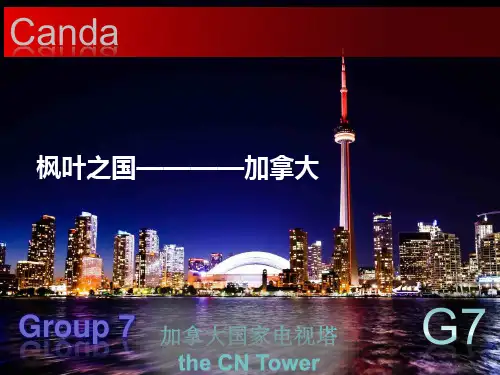
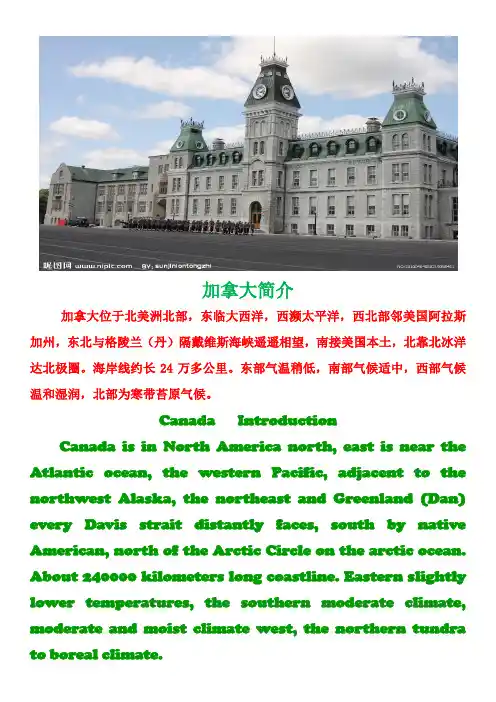
加拿大简介加拿大位于北美洲北部,东临大西洋,西濒太平洋,西北部邻美国阿拉斯加州,东北与格陵兰(丹)隔戴维斯海峡遥遥相望,南接美国本土,北靠北冰洋达北极圈。
海岸线约长24万多公里。
东部气温稍低,南部气候适中,西部气候温和湿润,北部为寒带苔原气候。
Canada IntroductionCanada is in North America north, east is near the Atlantic ocean, the western Pacific, adjacent to the northwest Alaska, the northeast and Greenland (Dan) every Davis strait distantly faces, south by native American, north of the Arctic Circle on the arctic ocean. About 240000 kilometers long coastline. Eastern slightly lower temperatures, the southern moderate climate, moderate and moist climate west, the northern tundra丹麦简介丹麦王国(丹麦文:Kongeriget Danmark)是斯堪的纳维亚组成国家之一,位于欧洲北部日德兰半岛上及附近岛屿。
南部就是德国,北部濒临大西洋、北海与波罗的海。
瑞典和挪威分别位于丹麦以北及西北方向,与丹麦隔海相望。
Denmark introductionDenmark kingdom (Denmark wen: Kongeriget Danmark) is one of the countries of Scandinavia, is located in the northern Europe Jutland and nearby islands. South is Germany, the northern borders the Atlantic ocean, the north sea and the Baltic sea. Sweden and Norway are located north of Denmark and northwest, and Denmark facing each other across the德国简介德国位于欧洲西部,东邻波兰、捷克,南接奥地利、瑞士,西接荷兰、比利时、卢森堡、法国,北与丹麦相连并邻北海和波罗的海与北欧国家隔海相望。
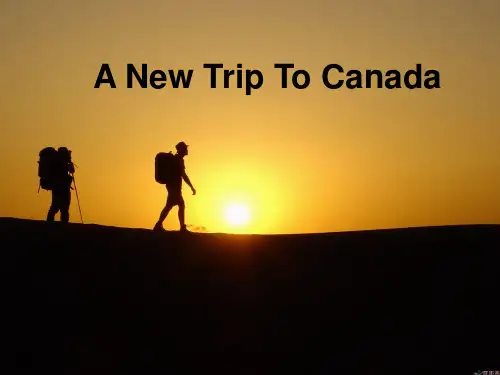
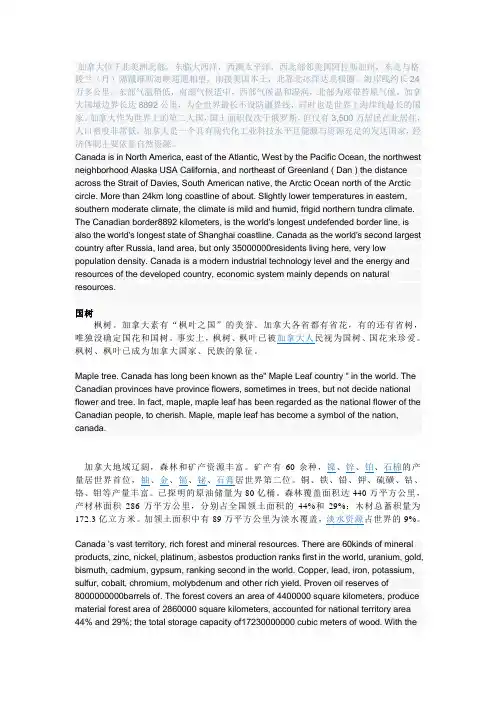
加拿大位于北美洲北部,东临大西洋,西濒太平洋,西北部邻美国阿拉斯加州,东北与格陵兰(丹)隔戴维斯海峡遥遥相望,南接美国本土,北靠北冰洋达北极圈。
海岸线约长24万多公里。
东部气温稍低,南部气候适中,西部气候温和湿润,北部为寒带苔原气候。
加拿大国境边界长达8892公里,为全世界最长不设防疆界线,同时也是世界上海岸线最长的国家。
加拿大作为世界上的第二大国,国土面积仅次于俄罗斯,但仅有3,500万居民在此居住,人口密度非常低。
加拿大是一个具有现代化工业科技水平且能源与资源充足的发达国家,经济体制主要依靠自然资源。
Canada is in North America, east of the Atlantic, West by the Pacific Ocean, the northwest neighborhood Alaska USA California, and northeast of Greenland ( Dan ) the distance across the Strait of Davies, South American native, the Arctic Ocean north of the Arctic circle. More than 24km long coastline of about. Slightly lower temperatures in eastern, southern moderate climate, the climate is mild and humid, frigid northern tundra climate. The Canadian border8892 kilometers, is the world's longest undefended border line, is also the world's longest state of Shanghai coastline. Canada as the world's second largest country after Russia, land area, but only 35000000residents living here, very low population density. Canada is a modern industrial technology level and the energy and resources of the developed country, economic system mainly depends on natural resources.国树枫树。
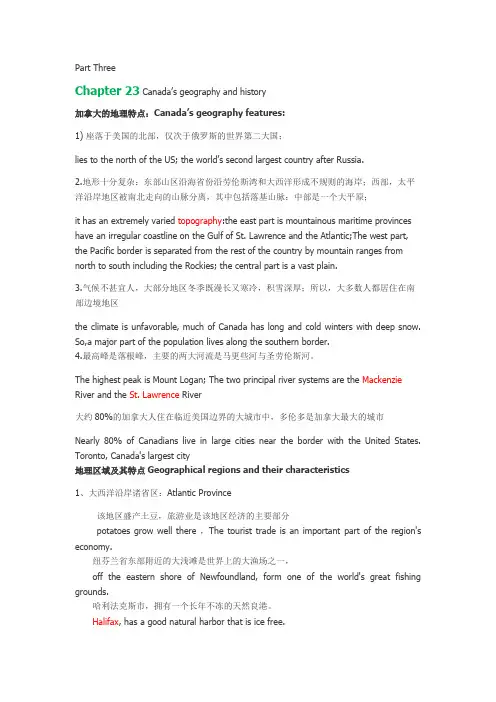
Part ThreeChapter 23Canada’s geography and history加拿大的地理特点:Canada’s geography features:1) 座落于美国的北部,仅次于俄罗斯的世界第二大国;lies to the north of the US; the world’s second largest country after Russia.2.地形十分复杂:东部山区沿海省份沿劳伦斯湾和大西洋形成不规则的海岸;西部,太平洋沿岸地区被南北走向的山脉分离,其中包括落基山脉;中部是一个大平原;it has an extremely varied topography:the east part is mountainous maritime provinces have an irregular coastline on the Gulf of St. Lawrence and the Atlantic;The west part,the Pacific border is separated from the rest of the country by mountain ranges from north to south including the Rockies; the central part is a vast plain.3.气候不甚宜人,大部分地区冬季既漫长又寒冷,积雪深厚;所以,大多数人都居住在南部边境地区the climate is unfavorable, much of Canada has long and cold winters with deep snow. So,a major part of the population lives along the southern border.4.最高峰是落根峰,主要的两大河流是马更些河与圣劳伦斯河。
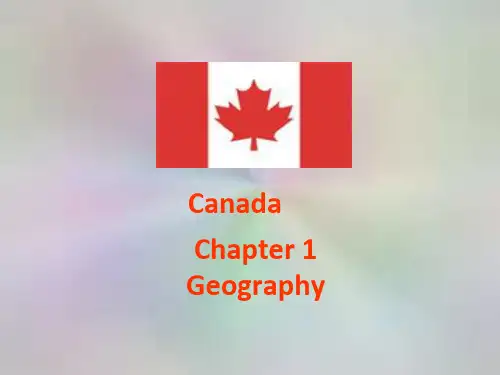

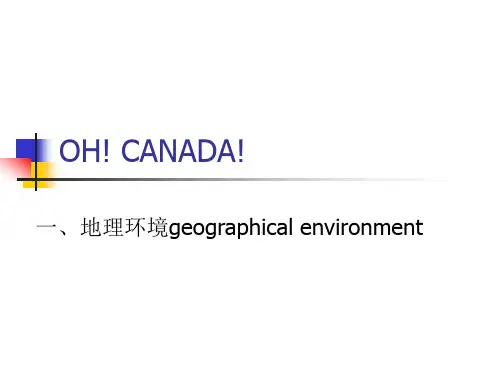
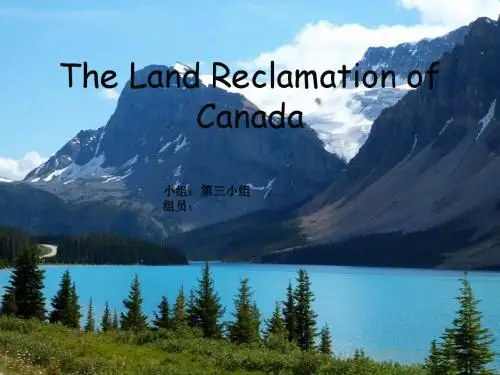

加拿大位于北美洲北部,东临大西洋,西濒太平洋,西北部邻美国阿拉斯加州,东北与格陵兰(丹)隔戴维斯海峡遥遥相望,南接美国本土,北靠北冰洋达北极圈。
海岸线约长24万多公里。
东部气温稍低,南部气候适中,西部气候温和湿润,北部为寒带苔原气候。
加拿大国境边界长达8892公里,为全世界最长不设防疆界线,同时也是世界上海岸线最长的国家。
加拿大作为世界上的第二大国,国土面积仅次于俄罗斯,但仅有3,500万居民在此居住,人口密度非常低。
加拿大是一个具有现代化工业科技水平且能源与资源充足的发达国家,经济体制主要依靠自然资源。
Canada is in North America, east of the Atlantic, West by the Pacific Ocean, the northwest neighborhood Alaska USA California, and northeast of Greenland ( Dan ) the distance across the Strait of Davies, South American native, the Arctic Ocean north of the Arctic circle. More than 24km long coastline of about. Slightly lower temperatures in eastern, southern moderate climate, the climate is mild and humid, frigid northern tundra climate. The Canadian border8892 kilometers, is the world's longest undefended border line, is also the world's longest state of Shanghai coastline. Canada as the world's second largest country after Russia, land area, but only 35000000residents living here, very low population density. Canada is a modern industrial technology level and the energy and resources of the developed country, economic system mainly depends on natural resources.国树枫树。
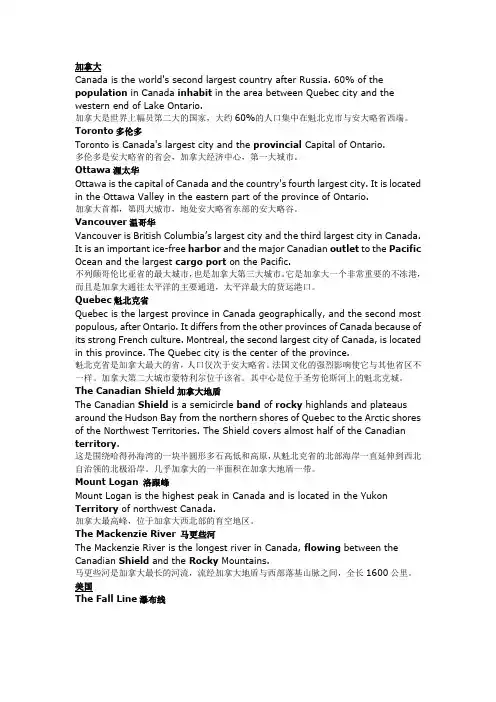
加拿大Canada is the world's second largest country after Russia. 60% of the population in Canada inhabit in the area between Quebec city and the western end of Lake Ontario.加拿大是世界上幅员第二大的国家,大约60%的人口集中在魁北克市与安大略省西端。
Toronto多伦多Toronto is Canada's largest city and the provincial Capital of Ontario.多伦多是安大略省的省会,加拿大经济中心,第一大城市。
Ottawa渥太华Ottawa is the capital of Canada and the country's fourth largest city. It is located in the Ottawa Valley in the eastern part of the province of Ontario.加拿大首都,第四大城市,地处安大略省东部的安大略谷。
Vancouver温哥华Vancouver is British Columbia’s largest city and the third largest city in Canada. It is an important ice-free harbor and the major Canadian outlet to the Pacific Ocean and the largest cargo port on the Pacific.不列颠哥伦比亚省的最大城市,也是加拿大第三大城市。
它是加拿大一个非常重要的不冻港,而且是加拿大通往太平洋的主要通道,太平洋最大的货运港口。
Quebec魁北克省Quebec is the largest province in Canada geographically, and the second most populous, after Ontario. It differs from the other provinces of Canada because of its strong French culture. Montreal, the second largest city of Canada, is located in this province. The Quebec city is the center of the province.魁北克省是加拿大最大的省,人口仅次于安大略省。
Canadaparallel 纬线prairie 草原sparse稀少的topograph 地形Arctic北极Municipalitan 自治市orient 东方的permanent永恒的rival 对手grant 准许discontent不满defuse缓和humidity湿气precipitation 降水量Charpter 1 Geography1.Location: It’s bordered by America on the south, the Atlantic Ocean on the eastand Pacific Ocean on the west ,and Arctic on the north.2.Area: 9984670 square kilometer3.Geographic region: Atlantic regionThe Central region The Prairie regionThe Pacific region The North region4.1st Mountain: Mount Logan(洛根山) 5959 meters5.1st Lake: Lake Superior 1st Fall: Nigara Falls6.Climate:Continental temperate zone大陆性温带针叶林气候(Canada has a typical continental climate, characterized by cold winters, hot summers and sparse rainfall. The Pacific region has a relatively moderate climate. Mild summers and winters,high humidity and abundant rianfull.In the Atlantic Region,the climate is marked by an cold winter, hot summer and sparse precipitation. Canadians enjoy four very distinct seasons)7.Major Cities:1st Toronto多伦多 2.5million.finacial capital.2nd Montreal蒙特利尔3rd Vancouver温哥华8.4th Ottawa渥太华capital8.Population: 3161万Britishdecendants42% Frenchdecendant26.7%Other Europeans13%Chinese decendants 3.5%Native people 3%9.Religion:Catholic 47.3% ,Christian 41.2%10.the Canadian National Anthem:国歌“O Canada”<《啊,加拿大》11;the National Flag of Canada 国旗“T he Maple Leaf “枫叶旗12:political districts:10 provinces +3TerritoryChapter 2. HistoryI.Discovery and Exploration1. 500 years ago, Indian and Inuit(因纽特人Canada is a young country,recorded history about 500 years. Before European, it was populated by Indian, and Inuit tribe.2.In 1535, Jacques Cartier, French navigatorfound Montreal.II.European Settlement1.in 1608, 1st colony—Quebec city魁北克市(France),with the rapid growthof English colonies along the Atlantic seaboard. Soon E&F became rivals.2.1756-1763, “Seven years War”;the whole Canada came under BritishcontrolIII.British Canada1.in 1774, Quebec Act 《魁北克法案》It granted the people of Quebec linguistic and religious freedom, and guaranteed the use of French civil law and British criminal law. So it was a milestone to unite French and British people into one country.2.Constitutional Act《宪法法案》in 1791Canada was split into Upper Canda and Lower Canada. Both colonies have limited self-government and political orgnization .3.in 1837, Revolt.Because of economy and religious discontent between the British and French community, the revolt was broke out. After the rebellions were put down in 1841,Upper and Lower Canada united as the British colony, the province of Canada by the Union Act (联合法案.)of the British congress.IV.Canadian Nation1.in 1867, British North America Act 《英属北美法》2.in 1926, Equal position in foreign affairs3.in 1931, the Statute of Westminister《威斯敏斯特法案》a member of the Commonwealth of Nations4.in 1967 the Quebec sovereignty movementCanada since 1980s1.in 1982, (英议会通过)the Canada Act《加拿大法案》,It made Canade a fully sovereign state (主权国家),1st July was decided as the national day of Canada.Chapter 3. Government and societyernmentA constitutional monarchy with a federal system of Parliamentary(君主立宪制+议会联邦制)1.the Legislature:立法the Parliament: the House of Common(众议院) 308人the Senate(参议院)105人2.the Executive:执法1)the federal government 联邦政府Governor General :总督Prime Minister:总理2)the provincial government 省政府3)the territorial government 地方政府3.the Judiciary司法a 4-level structure:the Supreme Courtthe federal Court Provincial CourtTerritorial Court4.Political Party1)The Liberal Party:(自由党)in 1867, largest party2)Conserative Party:(保守党)in 2003, a right-wingpolitical party3)The New Democratic Party:新民主党in 1961,a left-wing position5.ElectionIn 1867, whiteman In 1918, wemenIn 1960,aboriginal Candians土著加拿大人II. Society Economy:1) Canada is one of the world’s wealthiest nation, and the majority of its citizens enjoy a high quality of life by world standard.1.) Canada is a free market economy.2.) Canada is the ninth largest trade nation in the world.cation Canada has no national or federal departmetnt of education, itis the 10 provencies and 3 territories are responsible for education. Educationis compulsory for children from 6-16 years old.Public education is free to allcitizens to the end of secondary school.1)Elementary & Secondary school(6-16years old)1-7 grades Elementary schol小学8-12 grades Secondary school 中学a.Publicschool:freecompulsory education,with boys and girls togatherb.Private school:c.Missionary school 教会学校Secondary school2)Higher education:In Canada no Entrance Examination, no national enrollment system, eachcollege has its own enrollment standard.a.University综合大学College 学院Institute 专科College managementa.Semester system学期制b.Quarter system 学季制c.Trimester system 三学期制Laval Universaty 拉瓦尔大学1663The Universaty of Toronto 多伦多大学1827Queen’s University女王大学McGill University麦吉尔大学University of Ottawa渥太华大学3.Fastvals.(节假日)a.New years Day . 1st Jan.b.EasterDay.The1st Sundayafter21st.Marchc.Victoria Day (维多利亚日)24th.May (birthday of king Victoria)d.Canada Day ( 国庆节) 1st Julye.Thanksgiving Day 2nd Monday in Oct.f.Christmas Day 25th.Dec.g.Boxing Day (节礼日) 26th.Dec.h.Halloween (万圣节或鬼节) 31st Oct.。
加拿大十省三区一个远离尘器的穷乡僻壤;生活在革命势头正健,国家由农民向工业国过渡,新兴资产阶级日益壮大的时代,这些都给她的小说创作上打上了可见的烙印。
可惜,上帝似乎毫不吝啬的塑造了这个天才们。
有似乎急不可耐伸出了毁灭之手。
这些才华横溢的儿女,都无一例外的先于父亲再人生的黄金时间离开了人间。
惜乎,勃郎特姐妹!《简爱》这本小说,主要通过简。
爱与罗切斯特之间一波三折的爱情故事,塑造了一个出生低微、生活道路曲折,却始终坚持维护独立人格、追求个性自由、主张人生平等、不向人生低头的坚强女性。
简。
爱生存在一个父母双亡,寄人篱下的环境。
从小就承受着与同龄人不一样的待遇:姨妈的嫌弃,表姐的蔑视,表哥的侮辱和毒打。
然而,她并没有绝望,她并没有自我摧毁,并没有在侮辱中沉沦。
所带来的种种不幸的一切,相反,换回的却是简。
爱的无限信心,却是简。
爱的坚强不屈的精神,一种可战胜的内在人格力量。
不幸,在学习生活中,简。
爱仍然是承受着肉体上的受罚和心灵上的催残。
学校的施主罗可赫斯特不但当着全校师生的面诋毁她,而且把她置于耻辱台上示众。
使她在全校师生面前丢尽了脸。
但简。
爱仍坚强不屈,化悲愤为力量,不但在学习上飞速进步,而且也取得了师生们的理解。
不久,简。
爱又陷入了爱情的旋涡。
个性及强的她同样保持着个人高贵的尊严,在情敌面前显得大家闺秀,毫不逊色,对于英格拉姆小姐的咄咄逼人,她从容面对。
同样,在罗切斯特的面前,她从不因为自己是一个地位低贱的家庭教师,而感到自卑,她认为他们是平等的。
不应该因为她是仆人,而不能受到别人的尊重。
也正因为她的正直,高尚,纯洁,心灵没有受到世俗社会的污染。
使得罗切斯特感到自惭性秽,同时对她肃然起敬,并深深地爱上了她。
他的真心,让她感动,她接受了他。
后来,简。
爱发现罗切斯特已有了妻子,她的自尊自重再次出现,毫不犹豫地离开了他,她对爱情的专一,让我敬佩。
最后,简。
爱得知,罗切斯特为了拯救在活中的妻子不幸双目失明。
躯体严重残疾,完全丧失了生活能力,而同时又妻亡财毁。
CanadaCanada is a North American country consisting of ten provinces and three territories. Located in the northern part of the continent, it extends from the Atlantic Ocean in the east to the Pacific Ocean in the west and northward into the Arctic Ocean. It is the world's second largest country by total area. Canada's common border with the United States to the south and northwest is the longest in the world.Canada occupies a major northern portion of North America, sharing the land borders with the contiguous United States to the south and the U.S. state of Alaska to the northwest, stretching from the Atlantic Ocean in the east to the Pacific Ocean in the west; to the north lies the Arctic Ocean. By total area (including its waters), Canada is the second-largest country in the world, after Russia. By land area, Canada ranks fourth.Canada has one third of the world's supply of fresh water. There are five great lakes in the south, and there are many others, especially in the north. Most of the electricity is produced by water. The country has a great deal of coal, oil and natural gas, and these are all exploited for energy. Much of the country is covered by forests, and wood is cut and sold all over the world. Canada is also the world's biggest producer of the kind of paper which is used for newspapers. Fishing is also very important for Canadians. Fish from east and west coasts is sold to many other countries.About 40% of the Canadian population are of British descent, while 27% are of French origin. Another 20% are of other European background, about 10% are Asian origin, and some 3% are of aboriginal or Métis (mixed aboriginal and European) background.Canada is a federation of ten provinces (Alberta, British Columbia, Manitoba, New Brunswick, Newfoundland and Labrador, Nova Scotia, Ontario, Prince Edward Island, Quebec, and Saskatchewan) and three territories (Northwest Territories, Yukon, and Nunavut). It is governed as a parliamentary democracy and a constitutional monarchy with Queen Elizabeth II as its head of state. One of the world's highly developed countries, Canada has a diversified economy that is reliant upon its abundant natural resources and upon trade—particularly with the United States, with which Canada has had a long and complex relationship. It isa member of the G7, G8, G20, NATO, OECD, WTO, Commonwealth, Francophonie, OAS, APEC, and UN. With the eighth-highest Human Development Index globally, it has one of the highest standards of living in the world.The national flag of Canada, also known as the Maple Leaf, and l'Unifolié (French for "the one-leafed"), is a red flag with a white square in its centre, featuring a stylized 11-pointed red maple leaf. The width of the Maple Leaf flag is twice the height. The white field is a Canadian pale (a square central band in a vertical triband flag, named after this flag), and each bordering red field is exactly half its size.Canada's two official languages are English and French. English and French have equal status in federal courts, Parliament, and in all federal institutions. Citizens have the right, where there is sufficient demand, to receive federal government services in either English or French, and official-language minorities are guaranteed their own schools in all provinces and territories.Ottawa is the capital of Canada, the second largest city in the Provinceof Ontario, and the fourth largest city in the country. Located in the Ottawa Valley, the city lies in the eastern portion of Southern Ontario on the Ottawa River, a major waterway forming the local boundary between the provinces of Ontario and Quebec.Toronto is the provincial capital of Ontario and the largest city in Canada. It is located in Southern Ontario on the northwestern shore of Lake Ontario. With over 2.5 million residents, it is the fifth most populous city in North America. Its metropolitan area with over 5 million residents is the seventh largest urban region in North America.The Niagara Falls is the most powerful waterfalls in North America. These voluminous waterfalls are situated on the Niagara River, which drains Lake Erie into Lake Ontario and forms the international border between the Canadian province of Ontario and the U.S. state of New York. The Niagara Falls is renowned both for their beauty and as a valuable source of hydroelectric power.Vancouver is a coastal harbor city in Canada. Located in the LowerMainland, Greater Vancouver is the third-largest metropolitan area in the country and most populous in Western Canada. While forestry remains its largest industry, Vancouver is well known as an urban centre surrounded by nature, making tourism its second-largest industry. Vancouver has ranked highly in worldwide "livable city" rankings for more than a decade according to business magazine assessments and it was also acknowledged by Economist Intelligence Unit as the first city to rank among the top-ten of the world's most livable cities for five straight years. It has hosted many international conferences and events.Banff National Park is Canada's oldest national park, established in 1885 in the Rocky Mountains. The park, located 110–180 kilometers west of Calgary in the province of Alberta, encompasses 6,641 square kilometers of mountainous terrain, with numerous glaciers and ice fields, dense coniferous forest, and alpine landscapes.。
Canada is the world's longest coastline in the country. The southern border with the United States, the 8,892-km-long border. Across the northern part of the sea with Russia.As the cold northern climate, only 12% of the land suitable for farming. Therefore, most of Canada's 30 million people live in a mild climate, a few hundred kilometers from the southern boundary of the strip of territory, especially with the United States bordering the lakes and St. Lawrence region, flat, fertile land and rich natural resources. Canada is the most densely populated, most concentrated in the industrial and agricultural areas.Canadian lakes. If Xiatianfei over Northern Ontario or Manitoba, you will see the water than on land, and countless large and small lakes. According to estimates, Canada has the world's seventh volume of fresh water. In addition to the lakes connected with the United States and Canada, there are also many rivers. Canada is a very rich amount of rain and snow in the country have access to adequate water, trees and crops. thus grow lush busy.And pomegranate, a dazzling Xuefeng scenery is world-renowned.Canada's forest cover to 44% of the nation's total area, after Russia and Brazil, ranking third in the world. Canada is rich in mineral resources, is a world apart from the United States and Russia, one of the biggest mines.Canada has five geographical regions. Is the eastern Atlantic regions, the central area, grassland, the west coast region and the northern areas. Eastern areas to fisheries, agriculture, forest, mining, etc.; The central provinces of Ontario and Quebec is the most densely populated areas, Canada accounted for three-quarters of the industry are located here. Savanna including Manitoba. Saskatchewan moderate Alberta province, where flat land is fertile and rich in energy resources. British west coast region, is a famous mountain and forest areas, timber, fruits, rich in marine resources and other assets; from the northern Y ukon and Northwest Territories district composed abounds in oil, natural gas, gold, lead and zinc.History : the former residence of the Indians and Inuit. Into the 16th century, the British colonial government, and then he was ceded to Britain. 1867, the British Canadian province of New Brunswick as a joint federal and provincial Nuowasike homes. Britain became the first Dominion. Since then, other provinces are joining the Federation. 1926, the British recognized the increase of "equal status", plus the right to receive independent diplomacy. In 1931 and became member of the Commonwealth, the Board has agreed with the British Council equal legislative powers, but no constitutional amendment rights. 1982, Britain's Queen signed the "Constitution Act of Canada," Canadian Parliament was constitutional, the power of revising the constitution.翻译:加拿大是世界上海岸线最长的国家。